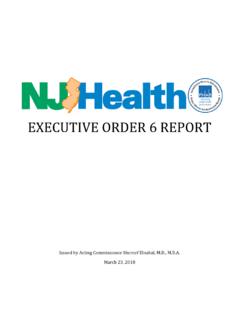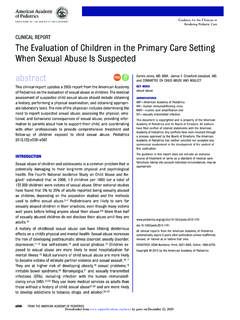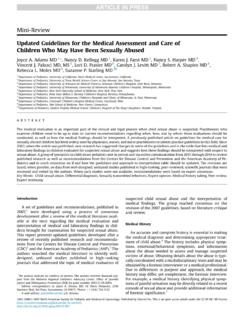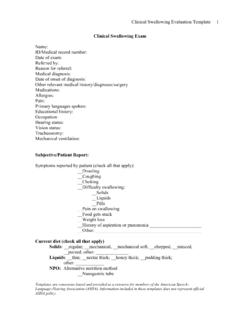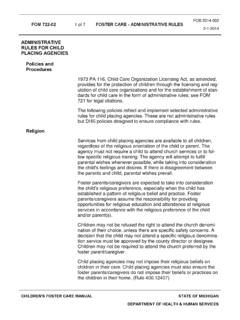Transcription of Technologies for Improving Post-Acute Care Transitions
1 Technologies for Improving Post-Acute Care Transitions Position Paper September 2010. Discussion Draft Table of Contents Executive Introduction ..4. Post-Acute Care Transitions and Hospital Evidence-Based Care Transitions The Care Transitions Intervention .. 6. The Transitional Care Model .. 7. Guided 8. Geriatric Resources for Assessment and Care of Elders .. 8. Technologies for Improving Post-Acute Care Medication Adherence Technologies ..12. Medication Reconciliation Technologies ..17. Remote Patient Monitoring Technologies ..21. Other Health Information and Communications Personal Health Records Technologies ..29. Social Networking Technologies ..30. Remote Training and Supervision Appendix A: List of Abbreviations ..36. Appendix B: Description of the Center for Technology and Aging Funding Opportunity ..38. 2010 Center for Technology and Aging 2. Executive Summary The recent focus on Improving Post-Acute care Transitions (the process by which a patient moves from hospital to home or other settings) is being driven by an interest in reducing hospital readmissions.
2 The United States has an 18% rate of hospital readmissions within 30 days of discharge and as many as 76% of these are preventable. According to Medicare data, over half of readmitted patients received no care or follow-up in the 30 days after Patients that do receive care after a hospital stay often experience care that is fragmented and uncoordinated, which results in duplication of services, inappropriate or conflicting care recommendations, medication errors, patient/caregiver distress, and higher costs of care. Recent studies by Coleman, Naylor, and others suggest that interventions targeted toward post - acute care Transitions can reduce readmission rates by one-third. These interventions focus on Improving the care Transitions process, providing direct patient support, Improving self- management capabilities, and increasing access to needed information and tools. The Care Transitions Intervention and the Transitional Care Model are two commonly used care process improvement interventions that focus on Post-Acute care Transitions .
3 The Guided Care and Geriatric Resources for Assessment and Care of Elders are promising care coordination intervention models that have care Transitions elements. Several types of Technologies have potential to support Post-Acute care Transitions interventions and are discussed in this position paper. Technologies that can assist in Improving medication adherence, medication reconciliation, patient monitoring, communications between and among clinicians, patients, and informal caregivers, risk assessment, and other important aspects of care Transitions are widely available, but often underutilized. Studies suggest that use of such Technologies can lead to fewer hospitalizations and emergency room visits, high patient satisfaction and acceptance, and reductions in cost of care. 2010 Center for Technology and Aging 3. Introduction In June 2010, the Center for Technology and Aging (CTA) announced the release of their Tech4 Impact Diffusion Grants Program with the aim to help selected states expand the use of Technologies for Improving Post-Acute care Transitions and reduce avoidable re- hospitalizations.
4 CTA's vision for the Tech4 Impact Diffusion Grants Program is that state-led aging and disability resource centers (ADRCs) will work with their community partners to expand use of patient-centered Technologies that will help recently hospitalized individuals maintain their health and independence and avoid re-hospitalizations. For further information on the Tech4 Impact Diffusion Grants Program, refer to Appendix B. This position paper illustrates some of the technology applications the Tech4 Impact grant aims to encourage. Note the paper is a starting point for consideration and is not meant to describe all possible Technologies for Improving Post-Acute care Transitions ( PACT Technologies ). The paper begins by describing the importance of Post-Acute care Transitions in hospital readmisssions. This is followed by a discussion of intervention models that aim to improve care Transitions processes.
5 Several example PACT technology focus areas are then reviewed. These include patient-centered medical devices and computer-based Technologies that better enable: Medication adherence ( , devices that remind patients to take the right medication at the right time and alert caregivers when a medication has not been taken). Medication reconciliation ( , software that stores medication information and detects potential problems, such as duplicate prescriptions). Remote patient monitoring, including Technologies that help detect early deterioration of a patient's health condition. Patient or caregiver access to health records and other important health information. Social support and communications between and among patients and caregivers. 2010 Center for Technology and Aging 4. Post-Acute Care Transitions and Hospital Readmissions The recent focus on Improving Post-Acute care Transitions (the process by which a patient moves from hospital to home or other settings) is being driven by an interest in reducing hospital readmissions.
6 The United States has an 18% rate of hospital readmissions within 30 days of discharge and as many as 76% of these are Reducing readmissions rates has become a high priority for policymakers and payers seeking to improve health care quality and contain costs. Researchers estimate that the national fiscal impact to Medicare as a result of unplanned hospital readmissions was $ billion in Re-hospitalization also appears to increase the risk of health complications, resulting in greater functional and cognitive impairments for In 2009, the Medicare Payment Advisory Council (MedPAC) concluded that a large proportion of re-hospitalizations is potentially preventable and recommended Improving Post-Acute care Transitions processes. Improvements include better communications and more coordinated care before and after Recent research on care Transitions activities (or care coordination programs with care Transitions elements) has established a strong evidence base for several types of interventions.
7 A. randomized controlled evaluation of the Care Transitions Intervention demonstrated that intervention subjects had lower re-hospitalization rates at 30 days and at 90 days compared to control subjects, and that the intervention group had mean hospital costs that were lower than the control A separate randomized evaluation of the Transitional Care Model showed that intervention patients had lower re-hospitalization and mean hospital costs than the control Among physician-based care management programs with care Transitions elements, a randomized study of the Geriatric Resources for Assessment and Care of Elders (GRACE) Model showed that for participants in a high-risk group, utilization of preventive services increased while the number of hospital admissions declined Moreover, a randomized study of Guided Care, a nurse-physician care management program, showed fewer hospital and nursing facility days for intervention participants than the control 2010 Center for Technology and Aging 5.
8 Evidence-Based Care Transitions Models Transitional care involves a set of actions, such as coordination among health professionals and education of the patients and caretakers that facilitate the continuity of patients' care as they transfer from one care setting, such as a hospital, to Four models are particularly relevant to this PACT technology review: 1) the Care Transitions Intervention, 2) the Transitional Care Model, 3) Guided Care, and 4) Geriatric Resources for Assessment and Care of Elders. The first two models emphasize hospital-to-home care Transitions , while the last two models emphasize practice-based care coordination that includes care Transitions elements. The Care Transitions Intervention The Care Transitions Intervention (CTI) is a four-week hospital-to-home care Transitions model during which patients with complex care needs and family caregivers receive specific tools and work with a Transitions Coach to learn self-management skills that will ensure their needs are met during the transition from hospital to home.
9 The intervention includes one hospital visit, one home visit, and three follow up phone calls by the Transitions Coach. The Transitions Coach is a person who has completed the Care Transitions Intervention interactive, face-to-face training with the Care Transitions Program team. This training ensures model fidelity. Providing continuity of care across settings, and supporting the patient in developing and maintaining a personal health record. Helping the patient and family members to understand when and how to obtain timely follow-up care (including both primary and specialty care). Coaching/role playing with patients to ask the right questions to the right health care providers to get their needs met across the various follow-up care settings. Helping patients and their families to play a more active role in managing their condition and to develop self-care skills, including medication self-management and increased awareness of symptoms, and recognizing red flags, and warning signs that trigger the need for care, along with instructions on how to respond to them.
10 The program has been tested with community dwelling adults that are 65 years or older with at least one of 11 diagnoses. A randomized study of the program showed that the program cost was $74,310 for 379 patients ($196/patient) and another study reported that intervention patients saw an estimated annual cost savings, over and above the cost of the intervention, of $844 per , 8. 2010 Center for Technology and Aging 6. The Transitional Care Model The Transitional Care Model (TCM) provides comprehensive discharge planning and home follow- up by advanced practice nurses (APNs) to older adults at high risk for poor outcomes. The following are core elements of the TCM: In-hospital assessment (including detailed assessment of each patient's functional status), collaboration with team members to reduce adverse events and prevent functional decline, and preparation and development of a streamlined, evidenced- based plan of care.
